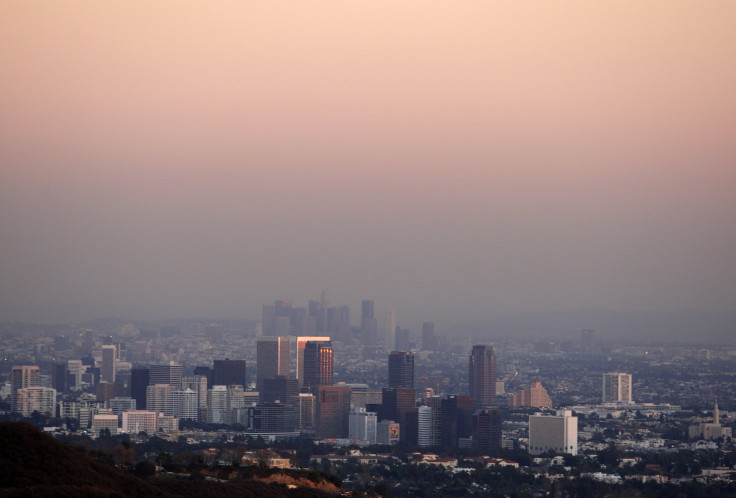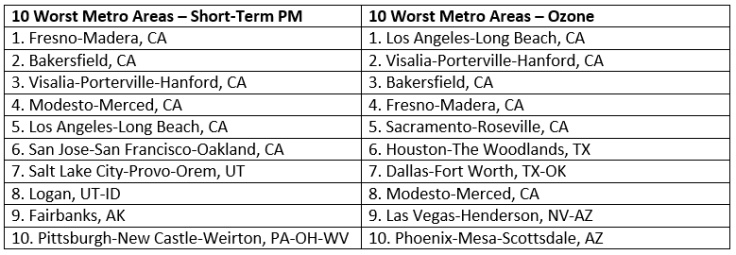California Drought 2015: Dry Air, Landscape Worsen State's Air Pollution

The drought destroying California’s farmlands and parching its wells has another consequence: dirtier air. Industrial cities in the Golden State are seeing higher levels of air pollution as a result of warmer, drier weather, a trend that is undermining statewide efforts to clean up emissions from power plants and tailpipes.
“Climate is playing a big role in the quality of air and impact on public health,” said Janice Nolen of the American Lung Association, in Washington. “As places have warmer temperatures, it’s harder to keep [pollution] under control.”
Nolen helps produce the group’s annual State of the Air report, which examines air quality measurements from 220 metropolitan areas. The 2015 study, released Wednesday, found that six of the 10 worst cities for air pollution are in California. Drought and hotter weather is causing a higher number of short-term pollution spikes in the state and other parts of the country, compared with the group’s 15 previous reports.
“These spikes in particles are something we haven’t seen before,” Nolen said. “I think we may see more of those in next year’s report.”

Particle pollution, also called particulate matter or PM, is a tiny mixture of acids, chemicals, metals, soil and dust that is formed when emissions from power plants, factories and vehicles react with the air. These particles are small enough to inhale and can damage people’s hearts and lungs over time, especially in growing children and older adults.
Central California has long struggled with particle pollution due to its industrial base and geography. The region is buzzing with oil and gas activity, refineries, power plants and vehicle traffic, and its arid climate and stagnant valley air allow the toxic emissions to build up in the atmosphere. In recent decades, California has dramatically reduced the thick smog and gray hazes that envelop its cities.
But California’s four-year drought is chipping away at some of that progress, the report found. Dry soil and nonexistent rains are allowing pollution to flourish. More frequent forest fires and dust storms are spewing more particles into the air.
In California, six metro areas recorded more high-particle days on average compared with last year’s report, including Los Angeles, San Jose-San Francisco, Sacramento, Fresno-Madera, Modesto-Merced and Visalia. On an annual basis, particle pollution was higher in San Jose-San Francisco, Modesto-Merced, El Centro and Bakersfield.
“Continued progress cleaning up pollution makes a difference, but a changing climate is making it harder to protect human health,” the American Lung Association said in its report.
Many of those same California cities topped the list for ozone pollution, as they have in earlier studies. Ozone is a colorless toxic gas created by chemical reactions with nitrogen and volatile organic compounds, and as with particle pollution, warmer temperatures can increase concentrations of ozone in the atmosphere.
California fared better on ozone compared with previous years. Los Angeles -- the No. 1 city for ozone pollution -- reported fewer high ozone days on average compared with the 2014 report, as did Sacramento, Bakersfield and Visalia. However, Fresno and Modesto-Merced experienced more high ozone days in this year's study.
Across the country, levels of ozone and particle pollution generally declined, and 13 cities recorded their cleanest years yet. Fewer people live in areas where pollution levels are often too dangerous to breathe compared with last year's study. About 44 percent of the U.S. population, or 138.5 million people, now live in such areas, down from 47 percent of the nation.
But encouraging trends in the nation’s air quality were largely overshadowed by growing concerns about climate change, Nolen said.
Rising global temperatures and higher levels of greenhouse gases “may increase the likelihood of more poor air quality days,” said Daniel Horton, a climate modeler at Stanford University in California, who was not involved with the American Lung Association report. He said that while the U.S. has significantly improved its air quality under state regulations and federal laws, including the Clean Air Act, those polices could soon become outdated as the climate changes.
The planet is on track to warm by 2 degrees Celsius (3.2 degrees Fahrenheit) in the next few decades as a result of burning fossil fuels and destroying forests and farmlands, which will worsen droughts, cause more extreme weather events and alter ecosystems, according to global climate scientists.
“We in the U.S. have actually improved our air quality over time. But I think we should feel a little bit of caution when we look at that success,” Horton said. “Climate change may start to erode a bit of that success.”
© Copyright IBTimes 2025. All rights reserved.





















